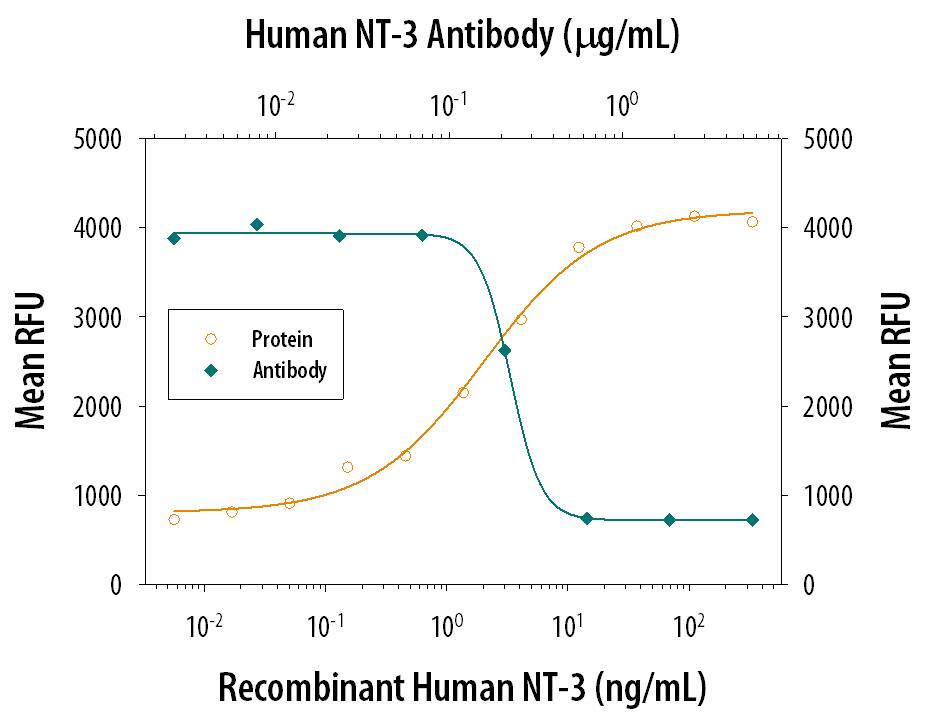Human NT-3 Antibody
R&D Systems, part of Bio-Techne | Catalog # AF-267-NA


Key Product Details
Species Reactivity
Validated:
Cited:
Applications
Validated:
Cited:
Label
Antibody Source
Product Specifications
Immunogen
Tyr139-Thr257
Accession # P20783
Specificity
Clonality
Host
Isotype
Endotoxin Level
Scientific Data Images for Human NT-3 Antibody
NT-3 in Rat Brain.
NT-3 was detected in perfusion fixed frozen sections of rat brain (Purkinje cells in the cerebellum) using 10 µg/mL Human NT-3 Antigen Affinity-purified Polyclonal Antibody (Catalog # AF-267-NA) overnight at 4 °C. Tissue was stained with the Anti-Goat HRP-AEC Cell & Tissue Staining Kit (red; Catalog # CTS009) and counterstained with hematoxylin (blue). View our protocol for Chromogenic IHC Staining of Paraffin-embedded Tissue Sections.Cell Proliferation Induced by NT‑3 and Neutralization by Human NT‑3 Antibody.
Recombinant Human NT-3 (Catalog # 267-N3) stimulates proliferation in BaF-TrKB-BD mouse pro-B cell line transfected with TrkB in a dose-dependent manner (orange line). Proliferation elicited by Recombinant Human NT-3 (20 ng/mL) is neutralized (green line) by increasing concentrations of Human NT-3 Antigen Affinity-purified Polyclonal Antibody (Catalog # AF-267-NA). The ND50 is typically 0.1-0.4 µg/mL.Applications for Human NT-3 Antibody
Immunohistochemistry
Sample: Perfusion fixed frozen sections of rat brain and immersion fixed parafin embedded human brain (Purkinje cells in the cerebellum)
Western Blot
Sample: Recombinant Human NT-3 (Catalog # 267-N3)
Neutralization
Reviewed Applications
Read 2 reviews rated 4.5 using AF-267-NA in the following applications:
Formulation, Preparation, and Storage
Purification
Reconstitution
Formulation
Shipping
Stability & Storage
- 12 months from date of receipt, -20 to -70 °C as supplied.
- 1 month, 2 to 8 °C under sterile conditions after reconstitution.
- 6 months, -20 to -70 °C under sterile conditions after reconstitution.
Background: NT-3
Neurotrophin-3 (NT-3) is a member of the NGF family of neurotrophic factors (also named neurotrophins) that are required for the differentiation and survival of specific neuronal subpopulations in both the central as well as the peripheral nervous systems. The neurotrophin family is comprised of at least four proteins including NGF, BDNF, NT-3, and NT-4/5. These secreted cytokines are synthesized as prepropeptides that are proteolytically processed to generate the mature proteins. All neurotrophins have six conserved cysteine residues that are involved in the formation of three disulfide bonds and all share approximately 55% sequence identity at the amino acid level. Similarly to NGF, bioactive NT-3 is predicted to be a non-covalently linked homodimer.
The NT-3 cDNA encodes a 257 amino acid residue precursor protein with a signal peptide and a proprotein that are cleaved to yield the 119 amino acid residue mature NT-3. The amino acid sequence of mature NT-3 is identical in human, mouse and rat. NT-3 transcripts have been detected in the cerebellum, hippocampus, placenta, heart, skin, and skeletal muscle. NT-3 primarily activates the TrkC tyrosine kinase receptor. In addition, NT-3 can activate Trk and TrkB kinase receptors in certain cell systems. NT-3 can also bind with low affinity to the low affinity NGF receptor.
References
- Eide, F.F. et al. (1993) Exp. Neurol. 121:200.
- Snider, W.D. (1994) Cell 77:627.
- Barbacid, M. (1994) J. Neurobiol. 25:1386.
Long Name
Alternate Names
Entrez Gene IDs
Gene Symbol
UniProt
Additional NT-3 Products
Product Documents for Human NT-3 Antibody
Product Specific Notices for Human NT-3 Antibody
For research use only
